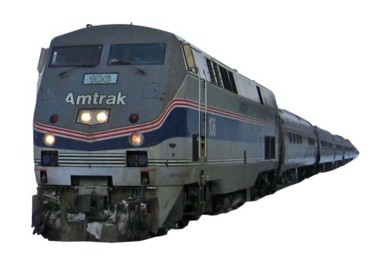The work is going on quietly, with no news events at the moment. The planning is so long-range that it’s easy to forget what was reported when the meetings were held and the grants were handed out. But a year from now, we’ll be close to a new era in passenger transit on the Valley’s railroads.
Not everyone will be happy about the changes. When the dust has settled, Amtrak won’t come to Amherst anymore; it will be back on its older route through Holyoke, Northampton and Greenfield, with tracks rebuilt under a $73 million stimulus grant.
“The work is underway as we speak,” Tim Brennan, director of the Pioneer Valley Planning Commission, told the Advocate. “Ties, rails, signals, intersections, crossings: the work on the ties has essentially been completed. The work on the rails has started, but it has to be paused through the winter. So probably we’ll get to Thanksgiving and begin shutting down, and the work would restart in the spring of ‘14.”
The current plan, Brennan said, is to get all the work finished by the end of next year and have the Amtrak intercity trains (“intercity” means trains traveling 100 miles or more between destinations) move over to their new routes early in 2015.
Brennan said that Pan Am, formerly Guilford Transportation, which owns the track leading through Northampton into Vermont, “is doing the work under the supervision of the MBTA.”
From the 1970s until 1995, Amtrak ran all the way from Washington, D.C. to Montreal on the Guilford right-of-way. But Guilford’s inability to keep the tracks in proper condition for railway cars running at passenger train speeds—which led to a Supreme Court case in 1992, after Amtrak had seized the Guilford right-of-way in order to continue passenger service on it—was one reason the Valley lost that train. So the fact that the MBTA is looking over Pan Am’s shoulder is probably good news. Another reason the MBTA is supervising the overhaul of the tracks is that the state of Massachusetts is buying the rail line from Pan Am.
“The details are being hammered out by the lawyers for each of the parties,” Brennan said. “They’re buying the entire corridor so they can protect it in the public interest.”
The big news—about a change that could make a difference to the quality of life in the Valley—is the possibility of commuter rail here, a subject on which Brennan offered some optimistic speculation. “The state of Connecticut for many years has planned to introduce new commuter rail service between New Haven, Hartford and Springfield,” he explained. “That would give a very significant boost to the level of service between Springfield and New Haven in 2016. That leads me to our hope that if we can get commuter service to Springfield and get a toehold there, we could pull the commuter service up the Valley.”
Brennan isn’t alone in that hope. In May, three Valley mayors, Bill Martin of Greenfield, David Narkewicz of Northampton and Alex Morse of Holyoke, wrote state transportation secretary Richard A. Davey a letter calling for more than the planned two train stops per day to run through their cities. Martin said he would like to see between four and seven stops per day in Greenfield.
Then there are other possibilities, including better connections between the Valley and Boston—an improvement that would be welcomed by many groups, from the area’s thousands of college students to people working in the state’s capital.
“Many years ago, then-Congressman Olver got an earmark for connecting our region with Boston,” Brennan pointed out. “After a long time, those funds have been released. The state has hired a consultant and work has just started up. A big question we got as we worked on north-south routes was, are we going to forget about our capital city? Also, Amtrak says it really needs the inland route because it’s run into problems with storms that don’t let the trains get through Rhode Island. Worcester has lots of commuter service [to Boston], and that has had a very important effect on Worcester’s downtown.”
Finally, do Valley residents dare to dream of getting back the lost connection to Montreal? Yes, said Brennan, though it’s hardly more than a dream at the moment, partly because September 11 caused tension about border crossings. “How do you do do the crossing of the border?” Brennan mused. “Do you do checks on the train? Do you take people off the train?”
Still, he said, “There’s a lot of very keen interest and work going on to reconnect to Montreal. The provincial government [in Quebec] seems keen about this reconnection and so do the three New England states involved, but it has to be an international solution. In order to keep the Valley a viable place to live, work, play, you’ve got to be connected. We don’t want to be a cul-de-sac. We want to be tied in as much as possible.”•



